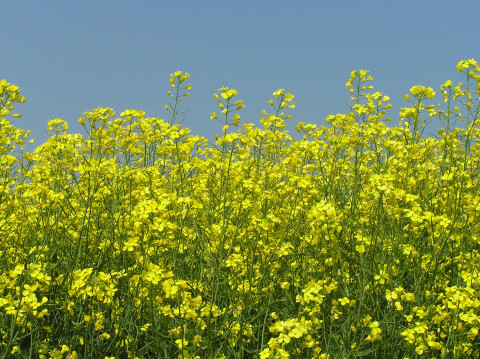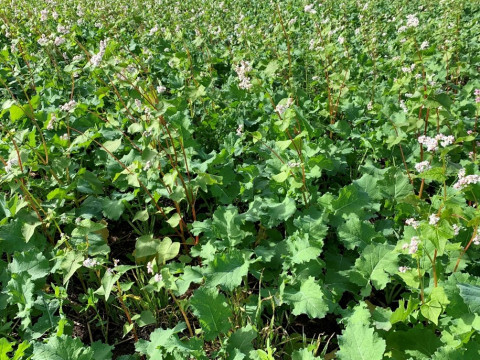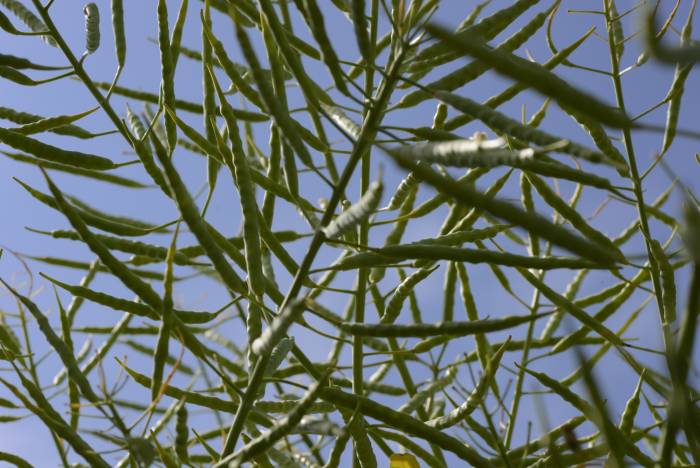Growing a successful oilseed rape crop
Oilseed rape (OSR) has the potential to be one of the most profitable break crops in a rotation, but it isn't without its challenges. Most notable are the difficulties in establishing, maintaining and protecting the crop from cabbage stem flea beetle (CSFB).
With the right guidance and support, OSR can deliver profitable margins for your business. But ultimately, crop success is dependent on good establishment so in this blog we're sharing some of the ways to help achieve this.
We can support you with the financial challenges surrounding OSR
Given the risks around growing OSR, Frontier has launched an industry-leading contract that helps farmers to grow the crop without the typical financial risks associated with it should it fail.
The scheme allows farmers to benefit from initial upfront savings as the payment date for any successfully established OSR and companion crop seed will be delayed to 12 months following delivery. If the crop fails, the OSR seed cost will be waived by Frontier altogether.
The contract is tailored to give growers access to a range of solutions so they stand the greatest chance of their OSR crop being a success, including high performing hybrid varieties, the expertise of a dedicated Frontier agronomist and support with additional measures such as the use of companion crops.
More information about the OSR de-risking partnership can be found here. Alternatively, you can get in touch with the partnership team.
Effective establishment methods
Once you've made the decision to grow OSR and have the ongoing support from Frontier, there are a few considerations when establishing OSR – CSFB control, variety, seed rate, seed treatments, nutrition and crop protection.
Minimising the impacts of CSFB
It's not new information that the establishment of OSR is heavily influenced by CSFB pressure. Unfortunately, there is no single measure that will resolve the threat from this pest or damage it causes. Instead, it's about adopting a wide range of integrated management practices and having an attention to detail approach.
You can find more information in this blog, where we talk about the importance of getting OSR off to the best start to lessen the impact of CSFB.
Variety selection
Many of the genetic traits of interest, such as turnip yellow virus (TuYV) resistance, pod shatter resistance and clubroot resistance, are most typically found in hybrid varieties.
Hybrid OSR tends to show greater early season vigour above standard conventional varieties. With quick establishment being key to growing away from CSFB, some evidence suggests that hybrids are therefore more likely to withstand adult CSFB grazing.
Establishment methods
Establishment is more than just drilling a crop at the same time you did last year. There are multiple factors at play.
1. Drilling date
There isn't a drill date that is sure to reduce CSFB damage. However, with the need to quickly establish the crop and with adult CSFB migrations continuing well into the autumn, it's best practice to drill early and into moisture.
Importantly, there are still risks with this approach. Early drilling can sometimes exacerbate other challenges in OSR, including clubroot and cabbage root fly. The latter is considered a minor pest and has no established thresholds, but crops that have emerged before the end of August are most at risk.
Looking at later drilled crops, these can suffer increased crop loss from adult grazing as the plants are smaller at the time of peak migration. On the flip side, however, they can experience less larvae damage because egg laying is reduced in cooler weather.
2. Conserving moisture
A fine, firm, moist seedbed will help to conserve moisture at drilling which in turn makes establishment more reliable while increasing vigour and availability of nutrition. This helps to establish the crop and get it to the 2-4 two leaf stage by the last week of August.
Ploughing or other high intensity cultivations that can result in the loss of moisture from the soil can negatively impact final yield and result in higher levels of CSFB larvae per plant.
A zero-till or direct drill method can conserve moisture and rolling (or even double rolling at a different angle to drilling) can also help close the rows and support moisture retention too.
3. Deciding whether to leave stubble
Straw management can be used to the benefit of the soil - chopped straw as a surface mulch which falls onto a dry soil will mean it stays that way as long as the straw intercepts the rain. Conversely if chopped straw goes onto a moist soil, it will help trap that moisture.
If the straw is baled and taken off the field, a lack of mulch on the soil surface will allow the rain to get to the soil surface or, in warmer conditions, can also result in the soil drying out faster.
Leaving long stubbles (above 20cm) provides benefits too, not only with moisture management but also shelter for natural CSFB predators and an element of 'visual confusion', whereby the CSFB can't locate OSR plants as well as they would if left on a pure soil surface.
4. Planting a companion crop alongside OSR
New data from a series of trials at Rothamsted Research (conducted in the UK and Germany), plus trials in Switzerland, has shown positive responses to companion cropping – stating a reduction in the effects of CSFB.
In this blog, Kings Crop technical advisor, Ed Jones, talks through the benefits of companion cropping, including how it can aid OSR establishment and how different cover crop species can help to alleviate different challenges.
Of particular interest is that legumes i.e. berseem clover and fenugreek, are nitrogen-fixing plants and can start doing this from the autumn if planted at the right time. This captured nitrogen is released to the OSR crop in the spring, which can in turn mean needing fewer crop inputs. A result of this is potentially lower greenhouse gas (GHG) emissions from production, helping to reduce your farm's climate impact overall.
Practices such as companion cropping can be funded privately via the supply chain, as well as through publicly-funded government schemes such as the Sustainable Farming Incentive (SFI) 2023. Actions 'IPM3' or 2024 'CIPM3' offer £55/ha for companion cropping on arable and horticultural land.
You can find more guidance on how to navigate funding for environmental actions here.
Seed rate and target plant populations
For hybrid varieties, the optimum seed rate for yield is 35-50 seeds/m2 while for conventional varieties it's 80-110 seeds/m2.
Data has shown that increasing the seed rate above these doesn't necessarily result in a consistent reduction in CSFB adult feeding damage and the number of CSFB larvae per plant are also not affected. Often there are more larvae per m2.
Plant population in the spring is important. The target for both conventional and hybrid varieties is 25-40/m2. This range is also applicable to autumn establishment numbers as there are generally fewer winter plant losses once the crop has gotten through the period of autumn adult CSFB feeding damage.
Seed treatments
Although some shy away from the use of seed treatments due to a perceived reduction in speed of establishment, their actual impact is likely to only cause a delay of around 12 hours.
If you're aiming to get seed into good, moist conditions this potential loss is more than compensated for with better establishment, stronger root growth and protection from damping off.
- Integral Pro
This bio-fungicide seed treatment (Bacillus amyloliquefaciens, MBI 600) protects the pathogenic fungi which can cause damping-off. When applied to seed, the beneficial microorganism in the product colonises the roots, providing the best activity for a bio-fungicide. The treatment has also been shown to stimulate plant defences and activities like root and shoot growth.
- Prosper ST
This seed treatment contains phosphite and a range of nutrients (N, P, K, Zn, Mg, Mn, Cu, B, Fe, Mo). It is proven to increase the speed of germination, particularly in colder seed beds. The phosphite encourages rapid root growth after emergence, with gains of up to 30% root mass improving access to soil moisture and nutrition. Nitrogen assimilation is also enhanced by the stimulation of the enzyme nitrate reductase, leading to subsequent increases in shoot growth.
Nutrition considerations
Supplying sufficient nutrition at or even before planting is essential to encourage early growth and establishment. In 2020 trials, the average yield increase from broadcast and placed starter fertilisers was 0.82t/ha. Nitrogen is key to achieving this by driving overall growth, but fresh phosphate supports the all-important root growth required for rapid crop establishment.
In 2023, we conducted a trial at our Bleasby 3D Thinking site which showed substantial benefits in improving crop biomass from the applications of chicken litter and digestate. As well as supplying the crop with applied nutrients, the use of manures, digestates and other organic matter-containing fertiliser helped maintain soil moisture.
If these materials aren't available and depending on your drill capabilities and establishment system, the following fertiliser, whether it be DAP, Oilseed Start, PhysioStart microgranules and OMEX liquid starter grades will all efficiently supply nitrogen and the phosphate which is vital for good establishment too.
- GroPlan P
At 0.75-1.0 l/ha at growth stage 13-14, this high strength foliar phosphite can help promote larger roots above and beyond just a Prosper seed treatment. Crop establishment is supported alongside increased nutrient uptake through a more rapidly developing root system, which in turn will be able to support increased shoot growth.
Crop protection
Pests
The most up-to-date data regarding the resistance status of CSFB comes from 2020 and shows 68.5% of the population was resistant to the pyrethroids insecticide, shifting from 55.6% the year before. Since 2020, this is likely to have increased further but despite the widespread resistance, pyrethroids remain the only option for control in oilseed rape.
However, trials have shown that earlier applications to adult populations of CSFB are more beneficial than later applications.
Weed control
Herbicides play a vital role in controlling grassweeds and should be considered pre- and post-emergence.
- Pre-emergence
If drilling early, applying a pre-emergence programme may prove beneficial. An application of metazachlor should be considered for crops with serious black-grass and ryegrass populations.
Pre-drilling glyphosate allows for a blank canvas and will be especially beneficial to OSR crops when large annual or perennial weeds remain from the previous crop.
- Peri- and post-emergence
Delaying the application of residual chemistry until the crop has emerged is often done as a way of mitigating financial loss should the crop fail. This approach can also help to avoid causing any following crop issues, such as residual chemistry reducing the establishment vigour of the next crop.
Summary
There are no silver bullets against the challenges often associated with OSR, but with the right advice, products and risk management solutions it remains a viable and important part of the rotation which can deliver great results for your farm business.
If you'd like more information about the topics discussed in this blog, please speak to your local Frontier contact or get in touch. More information about the OSR de-risking contract can be found here.
Need help navigating future funding?
Frontier has access to a range of unique private and public funding opportunities. To learn more about how you could add further value to your end market products, get in touch with a member of the team today: This email address is being protected from spambots. You need JavaScript enabled to view it..
As a subscriber, you’ll receive email alerts each time a new blog is published so you can always stay updated with the latest advice and insights from our experts










Comments